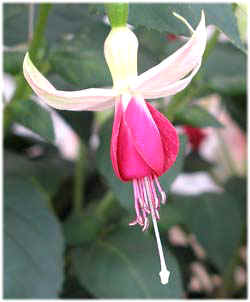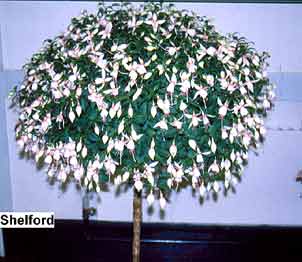
| Home |
| About Us |
| Growing |
| News |
| Shows |
| Varieties |
| Contacts |
| Links |
Growing StandardsVarieties suitable for full Standards:- Celia Smedley, -- seen below-- Joan Smith or Phyllis This type of growth form is really only practical for the greenhouse owner, if the larger specimens are to be constructed, as it is usual for the first season to be devoted to developing a strong, straight, stem or trunk and the commencement of the flowering head. It is rarely possible to produce a full standard in one season even when using the most vigorous of cultivars. The second season will achieve the full size of head, developing a depth and diameter in proportion to its overall height. For show purposes the BFS requirement for a
full stan A well rooted cutting with a potential for strong, vigorous growth should be selected and potted up into a pot size that will just accommodate the root system comfortably. A split cane is inserted, as near to the stem as possible, care being taken not to damage the young root system, and a tie should be made as low as possible to the cane. Support for the young plant is essential at this stage and any deviation from straight, upright, must be avoided by frequent ties as growth extension of the stem proceeds. The directional pull of light, or "phototropic" effect is very strong and once a curvature is established correction is rarely possible. At this stage growth is entirely concentrated
on building a strong trunk. Leaves must be retained to assist in the
process of enlarging the diameter of the trunk. Early laterals may
also be retained but should be removed before they affect the clean
line of the trunk, for if left to develop they often produce a
pronounced lump at the nodes. Particular attention must be paid to
potting requirements. It i As growth proceeds the development of the head section must be attended to. The number of laterals required for this is dependant to a great extent on trunk length, an important feature of a good standard being balance, that is ,the depth of head in relation to diameter and length of stem. This is usually considered to be a depth of head one third of total height, with the diameter of head in proportion to the depth. These measurements can only be an approximation and the grower will, with experience, develop his or her own individual style. Full weeping standards with a depth of head half the total height of the plant look delightful but are rarely seen these days in competition on the show bench. Once the full height is reached,30 in clear stem plus the section allowed for the depth of head, the top must be taken out and, if they have not already been removed ,all the side shoots up to the first break are removed. However the leaves must still be retained on the trunk at this time. The resulting lateral growth in the head section is allowed to develop and the first stop is dependant on the type of cultivar being used. It is impossible to state categorically that this should be done at two or three pairs of leaves, as much will depend on the length of joint between the leaves. One should be very conscious at this stage of the eventual diameter and density of the head required, and should attempt to visualise the number of stops possible to obtain the desired size and shape in the finished product. Stopping of laterals and side shoots continue gradually building up the head. Regular feeding with a balanced fertiliser is continued then when the laterals have been stopped twice all leaves are removed from the main stem. Many growers try to select shoots that have three leaves instead of leaves in pairs to use for standards as the head builds up more quickly. Half/Quarter Standards click Here
|

 dard is a clear stem of not less than 30 inches and of not
more than 42 inches from soil level to the first break.
dard is a clear stem of not less than 30 inches and of not
more than 42 inches from soil level to the first break. s very
important that no overcrowding of
roots occurs, as this will result in hard wood and an inducement to
flower. Roots should therefore be inspected frequently and, as soon as
they appear through the side of the root ball, the plant moved on to
the next size of pot. When repotting plants that are required to
produce fast. vigorous growth. they should always be potted on before
the roots emerging from the side of the root ball reach the bottom of
the pot. Failure to repot in good time will allow the roots to wind
around the ball and commence the "pot habit". If this is
allowed to proceed unchecked it will be almost impossible for the
roots to penetrate the fresh soil in any future potting.
s very
important that no overcrowding of
roots occurs, as this will result in hard wood and an inducement to
flower. Roots should therefore be inspected frequently and, as soon as
they appear through the side of the root ball, the plant moved on to
the next size of pot. When repotting plants that are required to
produce fast. vigorous growth. they should always be potted on before
the roots emerging from the side of the root ball reach the bottom of
the pot. Failure to repot in good time will allow the roots to wind
around the ball and commence the "pot habit". If this is
allowed to proceed unchecked it will be almost impossible for the
roots to penetrate the fresh soil in any future potting.